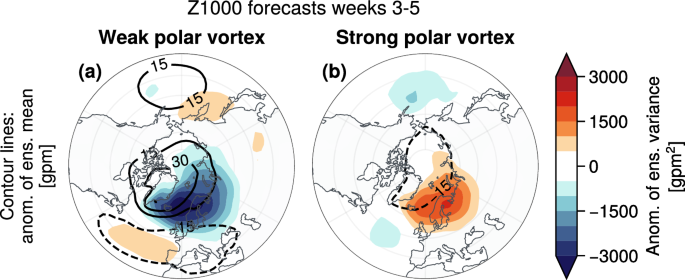2024-03-14 ミュンヘン大学(LMU)
<関連情報>
- https://www.lmu.de/en/newsroom/news-overview/news/meteorology-weak-polar-vortex-makes-weather-more-predictable.html
- https://www.nature.com/articles/s43247-024-01292-z
北半球外層域におけるサブシーズン予報の不確実性に対する成層圏の影響 Stratospheric impact on subseasonal forecast uncertainty in the Northern extratropics
Jonas Spaeth,Philip Rupp,Hella Garny & Thomas Birner
Communications Earth & Environment Published:14 March 2024
DOI:https://doi.org/10.1038/s43247-024-01292-z

Abstract
Extreme states of the polar stratospheric circulation during winter tend to be followed by anomalies in the near-surface circulation for several weeks, especially over the North Atlantic/Eurasia (NAE) sector. Previous research has highlighted an associated robust increase in subseasonal to seasonal (S2S) forecast skill related to forecast ensemble mean anomalies. Here we explore the additional impact of polar stratospheric circulation extremes on ensemble spread, a key measure of forecast uncertainty and the associated predictability. We find that over the Norwegian Sea and around Scandinavia S2S ensemble spread in near-surface geopotential height is significantly reduced following weak polar vortex states (enhanced predictability), whereas it is increased following strong polar vortex states (reduced predictability), with anomaly magnitudes reaching as high as 20%. Notably, modulations of forecast uncertainty are found even over regions of near-zero ensemble mean anomaly. We find decreased forecast uncertainty to be linked to decreased synoptic-scale storm activity and vice versa for increased forecast uncertainty. Our results furthermore suggest that modulation of S2S forecast uncertainty by the stratosphere dominates over NAE, whereas over the North Pacific modulations due to El Niño/ La Niña are more important.



